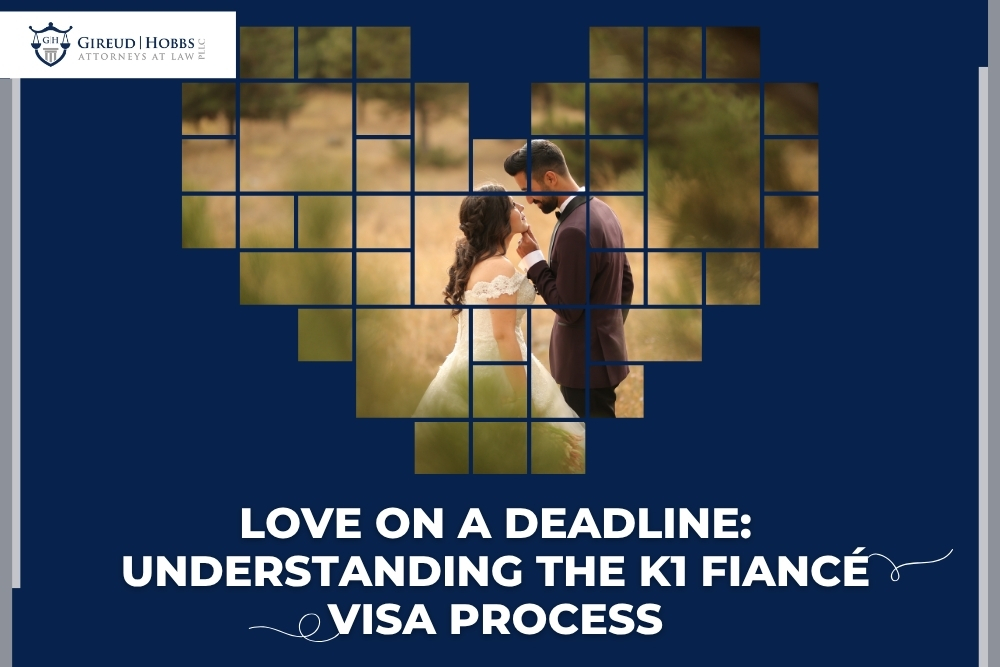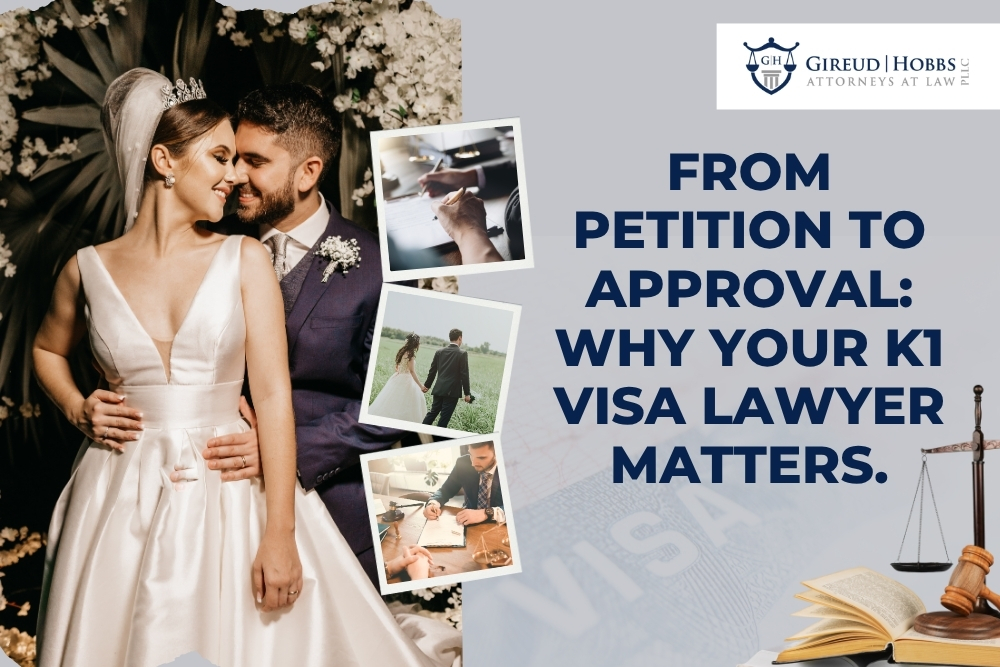If you’re a U.S. citizen marrying someone who’s not a United States citizen or lawful permanent resident, you might need a K1 visa. The K1 visa allows the fiancé(e) of a U.S. citizen to enter the United States for the purpose of getting married within the next 90 days. Here’s what you need to know.
Table of Contents
Request A Free Consultation Today!
Request A Free Consultation Today!
What is a K1 Visa?
A K1 visa, which is commonly just called a fiancé visa, is a document that allows a non-U.S. citizen or lawful permanent resident to enter the United States to get married.
The catch is that the couple only has 90 days to marry after the fiancé arrives in the country. If the couple fails to get married within that time, the foreign fiancé has to leave the country, apply for a new visa, and come back.

Does Everyone Need a Fiancé Visa?
Not everyone needs a fiancé visa. In fact, in some cases, it makes sense to get married and skip straight to applying for a spousal visa. It depends on how long you want to wait to be together, where you’re getting married, where you’re each living, and a variety of other factors. It’s a personal decision you should make with your soon-to-be spouse.
The K1 Visa Process
- Determine eligibility
- Gather documents
- Submit Form I-129F, Petition for Alien Fiancé(e)
- Do biometrics and a medical exam (if required)
- Attend a K1 visa interview
- Receive a decision
- Enter the U.S.
- Get married within 90 days
- Submit an adjustment of status application
K1 Visa Requirements
If you’re the fiancé, you can’t simply apply for the visa yourself. A U.S. citizen must sponsor you for this type of visa. These are the requirements for a fiancé visa:
- The sponsor must be a U.S. citizen. Lawful permanent residents are not eligible to petition the government to bring their fiancé to the United States.
- You must both be eligible to marry. That means you can’t be married to someone else (even if you’re in the process of a divorce), and you must be able to show that all prior marriages have been legally terminated. If you have a divorce decree, annulment or death certificate from a previous spouse – whether you’re the sponsor or the fiancé – you’ll need to submit it with your K1 visa petition.
- You must prove the legitimacy of your relationship. That means if you have photos, hotel reservations, flight itineraries or receipts from trips you took together, or written statements from people who are aware of your relationship, you’ll want to include them with your petition. You may also choose to include letters or emails you and your future spouse have sent to each other, phone records, or anything else that documents your relationship with one another.
- You must be able to prove that you have met in person at least once, and that your last meeting was within the two years before you filed your fiancé visa petition. However, if meeting would cause hardship to the U.S. citizen sponsor, or if it would violate religious, cultural or social norms, you can get a waiver. The evidence of your meeting can be the same evidence you use to prove the legitimacy of your relationship, such as flight itineraries, hotel reservations or photos of you together.
- You must both provide USCIS with a signed statement that says you intend to marry within 90 days of your arrival in the United States. If you’ve made wedding plans, you can also include evidence such as wedding invitations or receipts for deposits with photographers, a venue or catering.
- The U.S. citizen must provide evidence that they meet the K1 visa income requirements. In order to sponsor a K1 visa, the U.S. citizen must earn at least 100 percent of the federal poverty guidelines for their family size. Usually, the prior year’s tax return is sufficient evidence of this.
What Documents Are Needed For a Fiancé Visa?
Some information you’ll want to attach to your petition include:
- Proof of citizenship for the U.S. citizen, such as a copy of their birth certificate or U.S. passport
- A copy of the sponsored fiancé’s passport
- Proof of a bona fide (genuine) relationship
- Proof that you and your fiancé have met at least once in the past two years, such as flight itineraries or hotel reservations
- Sworn statements that say you intend to marry within 90 days of the sponsored fiancé’s arrival
- Evidence that you have planned a wedding, such as receipts for venues or catering
- If your spouse has ever received a Form I-94 arrival or departure record, a copy of that document
- One passport-style photo of the sponsored fiancé and the U.S. citizen sponsor
If you need additional documentation, your attorney can let you know. Your K1 visa lawyer will include the documentation with your petition so that you can avoid getting a Request for Evidence, or RFE, from U.S. Citizenship and Immigration Services (USCIS).
Request A Free Consultation Today!
Submit Form I-129F, Petition for Alien Fiancé(e)
Your K1 visa lawyer will submit Form I-129F and all the gathered documents. Including the documentation with your petition can help avoid getting a Request for Evidence, or RFE, from U.S. Citizenship and Immigration Services (USCIS) that slows down your case.
After USCIS receives your petition, it forwards your case to the U.S. Department of State.

Biometrics and Medical Exam
Once your case has been forwarded to the U.S. Department of State, the foreign fiancé(e) will receive instructions to attend a biometrics appointment and undergo a medical exam at an authorized clinic.
The biometrics appointment involves collecting fingerprints, photographs, and other identifying information for security clearance. Similarly, the medical exam is conducted to ensure the applicant meets the health requirements set by U.S. immigration law.
It is essential to attend these appointments promptly and follow the instructions provided by the designated officials to avoid any delays in processing the visa application.
The K1 Visa Interview
The sponsored fiancé will have to attend an interview at the nearest U.S. embassy or consulate to their home. Usually, the interview takes place a month to six weeks after receiving the notice. The interviewer will make a decision on the visa – sometimes at the interview, and sometimes shortly after. If the interviewer needs more evidence to make a decision, they will request that the sponsored fiancé sends it to the U.S. consulate.
Additional Documents Required For The K1 Visa Interview
Generally, about a month after the U.S. Department of State receives your petition, the sponsored fiancé will receive a notice from the U.S. embassy that includes their visa interview date. The notice may also include a list of required documents to bring to the interview, such as:
- Two passport-style photos
- A birth certificate
- A valid passport
- Police clearance from any countries that the sponsored fiancé has lived in for more than six months since turning 16
- A sealed medical exam form
K1 Visa Interview Questions
During the K1 visa interview, the consular officer will ask the sponsored fiancé a series of questions to determine the legitimacy of the relationship and the eligibility for the visa. These questions often focus on the history and details of the couple’s relationship, future plans, and personal backgrounds. Some common topics include:
- How did you meet your fiancé?
- When did your relationship begin?
- How often do you communicate with your fiancé?
- Have you met your fiancé’s family or friends?
- What are your wedding plans?
- Where does your fiancé live and what does he/she do for a living?
It is important to answer these questions honestly and confidently, as the purpose of the interview is to ensure the application meets all legal requirements.
The sponsored fiancé should also bring all required documents and any additional evidence that supports the relationship, such as photographs, emails, or travel itineraries. Being well-prepared for the interview can significantly increase the chances of a successful outcome.
How Long Do You Have to Come to the U.S. on a K1 Visa?
If your visa petition is approved, you must travel to the United States within six months. Then, after you arrive, you must marry your U.S. citizen fiancé within 90 days.
Adjustment of Status After Marriage
After you marry, your spouse can petition the U.S. government for an adjustment of status to get you a green card.
Request A Free Consultation Today!
K1 Visa FAQs
How long does a K1 visa take?
The processing time for a K1 visa can vary significantly, but on average, it takes approximately 6 to 12 months from the time you file the petition to when the visa is issued.
This timeline depends on several factors, such as the workload of USCIS and the U.S. consulate or embassy handling your case. It’s important to keep in mind that delays can occur due to incomplete documentation, background checks, or requests for additional evidence.
How much is a K1 visa?
The cost of a K1 visa includes several fees. The filing fee for the Form I-129F (Petition for Alien Fiancé(e)) is $535. Additionally, there is a K1 visa application fee of $265, which is paid at the U.S. embassy or consulate during the visa interview process.
Other potential costs may include medical examination fees, translation services for required documents, and travel expenses to attend the visa interview. It’s important to check for updated fee amounts on the USCIS website before beginning the process.
Can you work on a K1 visa?
Yes, you can work on a K1 visa, but only after obtaining work authorization. Once you arrive in the United States on a K1 visa, you can apply for a work permit by filing Form I-765, Application for Employment Authorization.
If you file for an Employment Authorization Document (EAD) while on a K1 visa, you will have to apply again once you submit your adjustment of status application. The EAD obtained during the K1 visa period is only valid for that short period of time and does not carry over to the adjustment of status process.
Is a K1 visa an immigrant visa?
The K1 visa is known as a “hybrid” visa. While it is technically classified as a nonimmigrant visa, it does have elements of an immigrant visa.
The ultimate goal of the K1 visa is for the foreign fiancé(e) to obtain a green card, but the K1 visa does not grant permanent residency status on its own. Instead, the foreign fiancé(e) must marry the U.S. citizen within 90 days of entering the country and then apply for adjustment of status to obtain a green card.
Request A Free Consultation Today!
Do You Need to Talk to K1 Visa Lawyer?
If you’d like to petition USCIS for a fiancé visa for your intended spouse, we may be able to help you. Call our office now to schedule a free consultation with an experienced, caring K1 visa lawyer who can answer your questions about the fiancé visa and help you get started on the right path.

